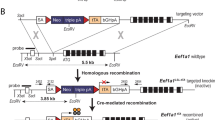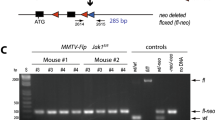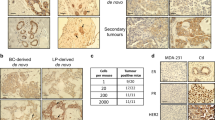Abstract
Decreasing the amount of active mouse Ets2 transcription factor by half in mice or use of a MAP kinase insensitive hypomorphic targeted Ets2 allele restricts the appearance of transgenic mammary tumors caused by either Polyoma middle T antigen (PyMT) or activated Neu/ErbB2. In addition, the early growth of transplanted mammary tumors is limited by restricted Ets2 activity of the host. Here we have tested genetically, with the use of a conditional Ets2flox allele and tissue specific Cre recombinase expression, whether Ets2 also functions within tumor cells by inactivating Ets2 within mammary luminal epithelial cells from which transgenic PyMTY315/322F tumors arise. We find that inactivation of Ets2 within tumor cells has no effect on tumor appearance or growth. By contrast, complete inactivation of Ets2 in both epithelial and stromal cells moderates the early hyperplastic phase of tumor development and the time of tumor appearance but does not prevent tumor occurrence and has no detectable effect on tumor growth. Thus, Ets2 supports mammary tumors exclusively through their microenvironment.
This is a preview of subscription content, access via your institution
Access options
Subscribe to this journal
Receive 50 print issues and online access
$259.00 per year
only $5.18 per issue
Buy this article
- Purchase on SpringerLink
- Instant access to full article PDF
Prices may be subject to local taxes which are calculated during checkout




Similar content being viewed by others
References
Andrechek ER, Hardy WR, Siegel PM, Rudnicki MA, Cardiff RD and Muller WJ . (2000). Proc. Natl. Acad. Sci. USA, 97, 3444–3449.
Guy CT, Cardiff RD and Muller WJ . (1992). Mol. Cell. Biol., 12, 954–961.
Hayashi S, Lewis P, Pevny L and McMahon AP . (2002). Mech. Dev., 119 (Suppl 1), S97–S101.
Hever A, Oshima RG and Hauser CA . (2003). Exp. Cell Res., 290, 132–144.
Lelievre E, Lionneton F, Soncin F and Vandenbunder B . (2001). Int. J. Biochem. Cell Biol., 33, 391–407.
Man AK, Young LJT, Tynan J, Lesperance J, Egeblad M, Hauser CA, Muller WJ, Cardiff RD and Oshima RG . (2003). Mol. Cell. Biol., 23, 8614–8625.
Neznanov N, Man AK, Yamamoto H, Hauser CA, Cardiff RD and Oshima RG . (1999). Cancer Res., 59, 4242–4246.
Oshima RG, Lesperance J, Munoz V, Hebbard L, Ranscht B, Sharan N, Muller WJ, Hauser CA and Cardiff RD . (2004). Cancer Res., 64, 169–179.
Sapi E, Flick MB, Rodov S and Kacinski BM . (1998). Cancer Res., 58, 1027–1033.
Sato Y . (2001). Cell Struct. Funct., 26, 19–24.
Tallquist MD and Soriano P . (2000). Genesis, 26, 113–115.
Webster MA, Hutchinson JN, Rauh MJ, Muthuswamy SK, Anton M, Tortorice CG, Cardiff RD, Graham FL, Hassell JA and Muller WJ . (1998). Mol. Cell. Biol., 18, 2344–2359.
Wei G, Guo J, Doseff AI, Kusewitt DF, Man AK, Oshima RG and Ostrowski MC . (2004). J. Immunol., 173, 137–139.
Wernert N, Raes M-B, Lassalle P, Dehouck MP, Gosselin B, Vandenbunder B and Stehelin D . (1992). Am. J. Pathol., 140, 119–127.
Yamamoto H, Flannery ML, Kupriyanov S, Pearce J, McKercher SR, Henkel GW, Maki RA, Werb Z and Oshima RG . (1998). Genes Dev., 12, 1315–1326.
Acknowledgements
We thank Dr Craig Hauser for helpful discussions and the Burnham Institute Animal Facility personnel for careful animal husbandry. This work was supported by grants from National Cancer Institute (CA74547 and CA098778 to RGO), the Department of Defense BCRP Predoctoral Fellowship (DAMD17-02-1-0316 to FW), and the National Cancer Institute Training Grant (1T32CA77109-04 to JAT).
Author information
Authors and Affiliations
Corresponding author
Rights and permissions
About this article
Cite this article
Tynan, J., Wen, F., Muller, W. et al. Ets2-dependent microenvironmental support of mouse mammary tumors. Oncogene 24, 6870–6876 (2005). https://doi.org/10.1038/sj.onc.1208856
Received:
Revised:
Accepted:
Published:
Issue Date:
DOI: https://doi.org/10.1038/sj.onc.1208856
Keywords
This article is cited by
-
The Ets dominant repressor En/Erm enhances intestinal epithelial tumorigenesis in ApcMin mice
BMC Cancer (2009)
-
Imaging and quantifying the dynamics of tumor-associated proteolysis
Clinical & Experimental Metastasis (2009)
-
Pten in stromal fibroblasts suppresses mammary epithelial tumours
Nature (2009)
-
Paradox of a tumour repressor
Nature (2008)



